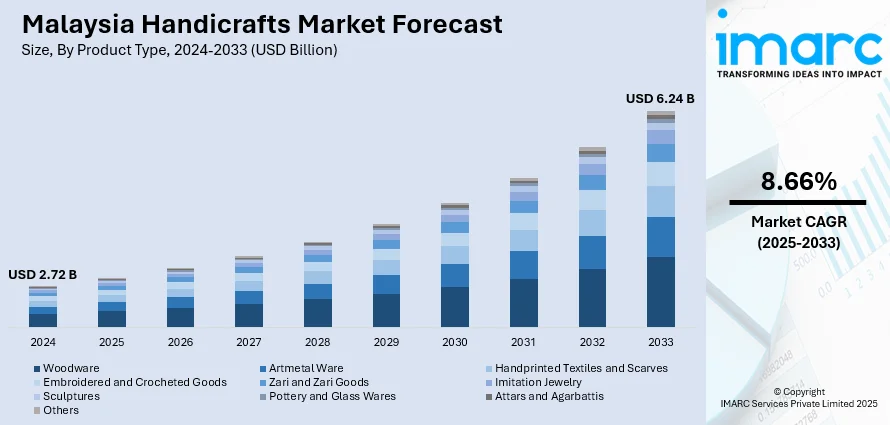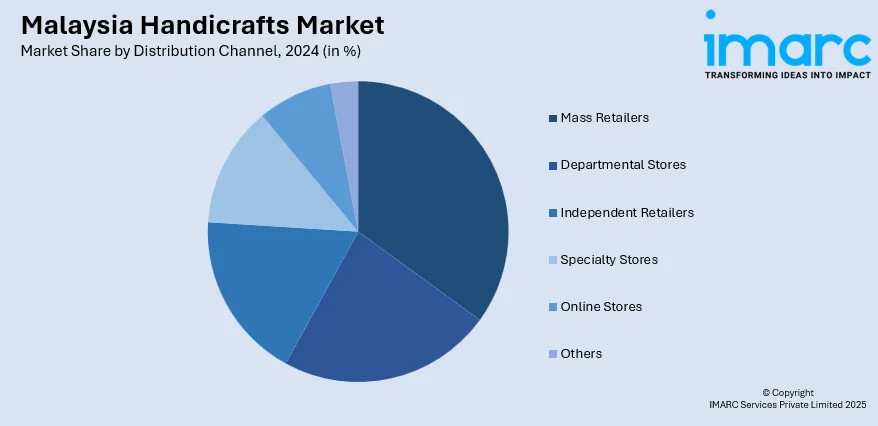
Malaysia Handicrafts Market Size, Share, Trends and Forecast by Product Type, Distribution Channel, End Use, and Region, 2025-2033
Malaysia Handicrafts Market Overview:
The Malaysia handicrafts market size reached USD 2.72 Billion in 2024. Looking forward, the market is projected to reach USD 6.24 Billion by 2033, exhibiting a growth rate (CAGR) of 8.66% during 2025-2033. The market is fueled by strong cultural traditions, government initiatives, and rising demand for eco-conscious, handmade products. Tourism and global exports further enhance visibility for local artisans. Malaysia handicrafts market share continues to grow due to its combination of cultural heritage and modern craftsmanship.
|
Report Attribute
|
Key Statistics
|
|---|---|
|
Base Year
|
2024
|
|
Forecast Years
|
2025-2033
|
|
Historical Years
|
2019-2024
|
| Market Size in 2024 | USD 2.72 Billion |
| Market Forecast in 2033 | USD 6.24 Billion |
| Market Growth Rate 2025-2033 | 8.66% |
Malaysia Handicrafts Market Trends:
Eco-Friendly and Locally Sourced Materials
Sustainability is a key driver of Malaysia handicrafts market growth, with artisans increasingly adopting eco-friendly materials such as bamboo, rattan, recycled wood, and organic fabrics. Traditional weaving and basketry techniques are being combined with sustainable practices, appealing to both domestic consumers and international buyers. Eco-certifications and green labeling have also become valuable selling points. Tourism and export markets are particularly drawn to products that blend cultural design elements with environmentally responsible production. Support from government agencies like Kraftangan Malaysia further encourages artisans to explore sustainable innovation. This eco-conscious approach is ensuring both the preservation of natural resources and long-term competitiveness in the global handicraft sector. For instance, Malaysia announced plans to highlight its local handicraft heritage at the 2025 Asean Summit, with all gifts and souvenirs sourced from Malaysian artisans. This initiative, tied to Malaysia’s Asean 2025 chairmanship, aims to boost the handicraft sector, promote cultural authenticity, and create economic opportunities through over 270 planned meetings and events nationwide.

To get more information on this market, Request Sample
Rise of Digital Marketing and Online Sales
At the beginning of 2024, Malaysia had 33.59 million internet users, reflecting an internet penetration rate of 97.4 percent. As of January 2024, the country recorded 28.68 million social media users, representing 83.1 percent of its population. Additionally, there were 44.55 million active cellular mobile connections, equivalent to 129.2 percent of the population. Digitalization has transformed the handicrafts sector in Malaysia, with online platforms such as Shopee, Lazada, and Etsy connecting artisans directly to local and international consumers. Social media platforms are being used for brand storytelling, highlighting the craftsmanship behind each product. Virtual marketplaces, live streaming sessions, and digital trade fairs have increased visibility for small artisans. Government-led programs support artisans with digital training, enabling them to scale their online presence. As e-commerce continues to thrive, Malaysian handicrafts are reaching a broader audience, creating new revenue streams and contributing to Malaysia handicrafts market growth.
Malaysia Handicrafts Market Segmentation:
IMARC Group provides an analysis of the key trends in each segment of the market, along with forecasts at the region/country level for 2025-2033. Our report has categorized the market based on product type, distribution channel, and end use.
Product Type Insights:
- Woodware
- Artmetal Ware
- Handprinted Textiles and Scarves
- Embroidered and Crocheted Goods
- Zari and Zari Goods
- Imitation Jewelry
- Sculptures
- Pottery and Glass Wares
- Attars and Agarbattis
- Others
The report has provided a detailed breakup and analysis of the market based on the product type. This includes woodware, artmetal ware, handprinted textiles and scarves, embroidered and crocheted goods, zari and zari goods, imitation jewelry, sculptures, pottery and glass wares, attars and agarbattis, and others.
Distribution Channel Insights:

- Mass Retailers
- Departmental Stores
- Independent Retailers
- Specialty Stores
- Online Stores
- Others
A detailed breakup and analysis of the market based on the distribution channel have also been provided in the report. This includes mass retailers, departmental stores, independent retailers, specialty stores, online stores, and others.
End Use Insights:
- Residential
- Commercial
The report has provided a detailed breakup and analysis of the market based on the end use. This includes residential and commercial.
Regional Insights:
- Selangor
- W.P. Kuala Lumpur
- Johor
- Sarawak
- Others
The report has also provided a comprehensive analysis of all the major regional markets, which include Selangor, W.P. Kuala Lumpur, Johor, Sarawak, and others.
Competitive Landscape:
The market research report has also provided a comprehensive analysis of the competitive landscape. Competitive analysis such as market structure, key player positioning, top winning strategies, competitive dashboard, and company evaluation quadrant has been covered in the report. Also, detailed profiles of all major companies have been provided.
Malaysia Handicrafts Market Report Coverage:
| Report Features | Details |
|---|---|
| Base Year of the Analysis | 2024 |
| Historical Period | 2019-2024 |
| Forecast Period | 2025-2033 |
| Units | Billion USD |
| Scope of the Report |
Exploration of Historical Trends and Market Outlook, Industry Catalysts and Challenges, Segment-Wise Historical and Future Market Assessment:
|
| Product Types Covered | Woodware, Artmetal Ware, Handprinted Textiles and Scarves, Embroidered and Crocheted Goods, Zari and Zari Goods, Imitation Jewelry, Sculptures, Pottery and Glass Wares, Attars and Agarbattis, Others |
| Distribution Channels Covered | Mass Retailers, Departmental Stores, Independent Retailers, Specialty Stores, Online Stores, Others |
| End Uses Covered | Residential, Commercial |
| Regions Covered | Selangor, W.P. Kuala Lumpur, Johor, Sarawak, Others |
| Customization Scope | 10% Free Customization |
| Post-Sale Analyst Support | 10-12 Weeks |
| Delivery Format | PDF and Excel through Email (We can also provide the editable version of the report in PPT/Word format on special request) |
Key Questions Answered in This Report:
- How has the Malaysia handicrafts market performed so far and how will it perform in the coming years?
- What is the breakup of the Malaysia handicrafts market on the basis of product type?
- What is the breakup of the Malaysia handicrafts market on the basis of distribution channel?
- What is the breakup of the Malaysia handicrafts market on the basis of end use?
- What is the breakup of the Malaysia handicrafts market on the basis of region?
- What are the various stages in the value chain of the Malaysia handicrafts market?
- What are the key driving factors and challenges in the Malaysia handicrafts market?
- What is the structure of the Malaysia handicrafts market and who are the key players?
- What is the degree of competition in the Malaysia handicrafts market?
Key Benefits for Stakeholders:
- IMARC’s industry report offers a comprehensive quantitative analysis of various market segments, historical and current market trends, market forecasts, and dynamics of the Malaysia handicrafts market from 2019-2033.
- The research report provides the latest information on the market drivers, challenges, and opportunities in the Malaysia handicrafts market.
- Porter's five forces analysis assist stakeholders in assessing the impact of new entrants, competitive rivalry, supplier power, buyer power, and the threat of substitution. It helps stakeholders to analyze the level of competition within the Malaysia handicrafts industry and its attractiveness.
- Competitive landscape allows stakeholders to understand their competitive environment and provides an insight into the current positions of key players in the market.
Need more help?
- Speak to our experienced analysts for insights on the current market scenarios.
- Include additional segments and countries to customize the report as per your requirement.
- Gain an unparalleled competitive advantage in your domain by understanding how to utilize the report and positively impacting your operations and revenue.
- For further assistance, please connect with our analysts.
 Request Customization
Request Customization
 Speak to an Analyst
Speak to an Analyst
 Request Brochure
Request Brochure
 Inquire Before Buying
Inquire Before Buying




.webp)




.webp)












